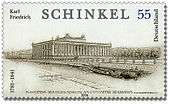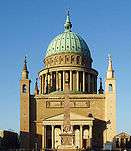Karl Friedrich Schinkel

Karl Friedrich Schinkel (13 March 1781 – 9 October 1841) was a Prussian architect, city planner, and painter who also designed furniture and stage sets. Schinkel was one of the most prominent architects of Germany and designed both neoclassical and neogothic buildings.[1] His most famous buildings are found in and around Berlin.
Biography


Schinkel was born in Neuruppin, Margraviate of Brandenburg. When he was six, his father died in the disastrous Neuruppin fire of 1787. He became a student of architect Friedrich Gilly (1772–1800) (the two became close friends) and his father, David Gilly, in Berlin. After returning to Berlin from his first trip to Italy in 1805, he started to earn his living as a painter. Working for the stage he created in 1816 a star-spangled backdrop for the appearance of the "Königin der Nacht" in Wolfgang Amadeus Mozart's opera The Magic Flute, which is even quoted in modern productions of this perennial piece. When he saw Caspar David Friedrich's painting Wanderer above the Sea of Fog at the 1810 Berlin art exhibition he decided that he would never reach such mastery of painting and turned to architecture. After Napoleon's defeat, Schinkel oversaw the Prussian Building Commission. In this position, he was not only responsible for reshaping the still relatively unspectacular city of Berlin into a representative capital for Prussia, but also oversaw projects in the expanded Prussian territories from the Rhineland in the west to Königsberg in the east, such as New Altstadt Church.
From 1808 to 1817 Schinkel renovated and reconstructed Schloss Rosenau, Coburg, in the Gothic Revival style.[2] He also rebuilt the ruins of Chorin Abbey.
Style



Schinkel's style, in his most productive period, is defined by a turn to Greek rather than Imperial Roman architecture, an attempt to turn away from the style that was linked to the recent French occupiers. (Thus, he is a noted proponent of the Greek Revival.) He believed that in order to avoid sterility and have a soul, a building must contain elements of the poetic and the past, and have a discourse with them.[3][4]
His most famous extant buildings are found in and around Berlin. These include the Neue Wache (1816–1818), the National Monument for the Liberation Wars (1818–1821), the Schauspielhaus (1819–1821) at the Gendarmenmarkt, which replaced the earlier theatre that was destroyed by fire in 1817, and the Altes Museum on Museum Island (1823–1830). He also carried out improvements to the Crown Prince's Palace and to Schloss Charlottenburg. Schinkel was also responsible for the interior decoration of a number of private Berlin residences. Although the buildings themselves have long been destroyed portions of a stairwell from the Weydinger House could be rescued and built into the Nicolaihaus on Brüderstr. and its formal dining hall into the Palais am Festungsgraben.
Later, Schinkel moved away from classicism altogether, embracing the Neo-Gothic in his Friedrichswerder Church (1824–1831). Schinkel's Bauakademie (1832–1836), his most innovative building, eschewed historicist conventions and seemed to point the way to a clean-lined "modernist" architecture that would become prominent in Germany only toward the beginning of the 20th century.
Schinkel died in Berlin, Province of Brandenburg.
Schinkel, however, is noted as much for his theoretical work and his architectural drafts as for the relatively few buildings that were actually executed to his designs. Some of his merits are best shown in his unexecuted plans for the transformation of the Athenian Acropolis into a royal palace for the new Kingdom of Greece and for the erection of the Orianda Palace in the Crimea. These and other designs may be studied in his Sammlung architektonischer Entwürfe (1820–1837) and his Werke der höheren Baukunst (1840–1842; 1845–1846). He also designed the famed Iron Cross medal of Prussia, and later Germany.
It has been speculated, however, that due to the difficult political circumstances – French occupation and the dependency on the Prussian king – and his relatively early death, which prevented him from seeing the explosive German industrialization in the second half of the 19th century, he was not able to live up to the true potential exhibited by his sketches.
Paintings and drawings
- Karl Friedrich Schinkel's paintings
 Gothic Cathedral by the Water
Gothic Cathedral by the Water Karl Friedrich Schinkel's stage set for Mozart's Magic Flute
Karl Friedrich Schinkel's stage set for Mozart's Magic Flute Christian Peter Wilhelm Beuth and Prussia's industrial renewal's allegory
Christian Peter Wilhelm Beuth and Prussia's industrial renewal's allegory- Medieval City on a River
 Rock Arch
Rock Arch- View of Mont Blanc
 Morning
Morning
Buildings
- Selection of Karl Friedrich Schinkel's works
 Konzerthaus, Berlin
Konzerthaus, Berlin


- Alexander Nevsky chapel, Peterhof, Russia


See also
References and sources
- References
- ↑ Karl Friedrich Schinkel – Facts, information, pictures – Encyclopedia.com
- ↑ Charles Quest-Ritson, 'Coburg: Schloß Rosenau', in Gärten in Deutschland, p. 64 online (in German)
- ↑ Guratzsch, Dankwart (2016-01-13). "Wie Bürger für die Schönheit ihrer Städte kämpfen". Welt Online. Retrieved 2016-05-24.
- ↑ Peik, Susan M. (2001). Karl Friederich Schinkel: Aspects Of His Work. Stuttgart/London: Axel Menges. p. 7. ISBN 3-930698-81-1.
- Sources
- Karl Friedrich Schinkel 1781 - 1841: the drama of architecture, ed. by John Zukowsky. With essays by Kurt W. Forster and Wolfgang Pehnt, ISBN 0-86559-105-9.
- Jörg Trempler: Schinkels Motive. Matthes & Seitz, Berlin 2007, ISBN 978-3-88221-866-4.
- Christoph Werner: Schloss am Strom. Die Geschichte vom Leben und Sterben des Baumeisters Karl Friedrich Schinkel. Bertuch-Verlag, Weimar 2004, ISBN 3-937601-11-2.
- Christoph von Wolzogen: Karl Friedrich Schinkel: Unter dem bestirnten Himmel. Biographie. Edition Fichter, Frankfurt 2016, ISBN 978-3-943856-33-0.
External links
| Wikimedia Commons has media related to Karl Friedrich Schinkel. |
| Wikiquote has quotations related to: Karl Friedrich Schinkel |
-
 Chisholm, Hugh, ed. (1911). "Schinkel, Karl Friedrich". Encyclopædia Britannica (11th ed.). Cambridge University Press.
Chisholm, Hugh, ed. (1911). "Schinkel, Karl Friedrich". Encyclopædia Britannica (11th ed.). Cambridge University Press. - Carter, Rand. "Karl Friedrich Schinkel, The Last Great Architect". Prefatory essay from Collection of Architectural Designs including those designs which have been executed and objects whose execution was intended by Karl Friedrich Schinkel (Chicago: Exedra Books Incorporated, 1981). Also used as a reference.